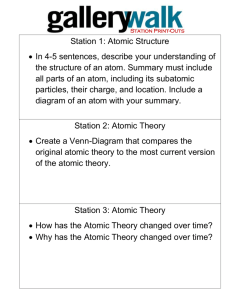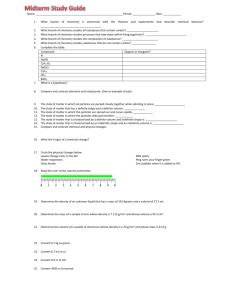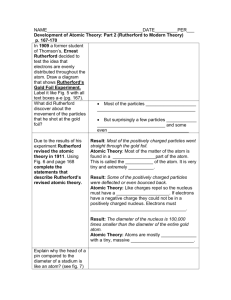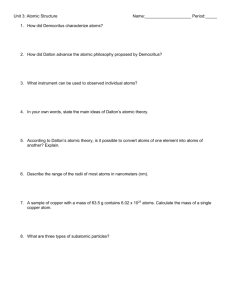Atomic History Unit - Menifee County Schools
advertisement
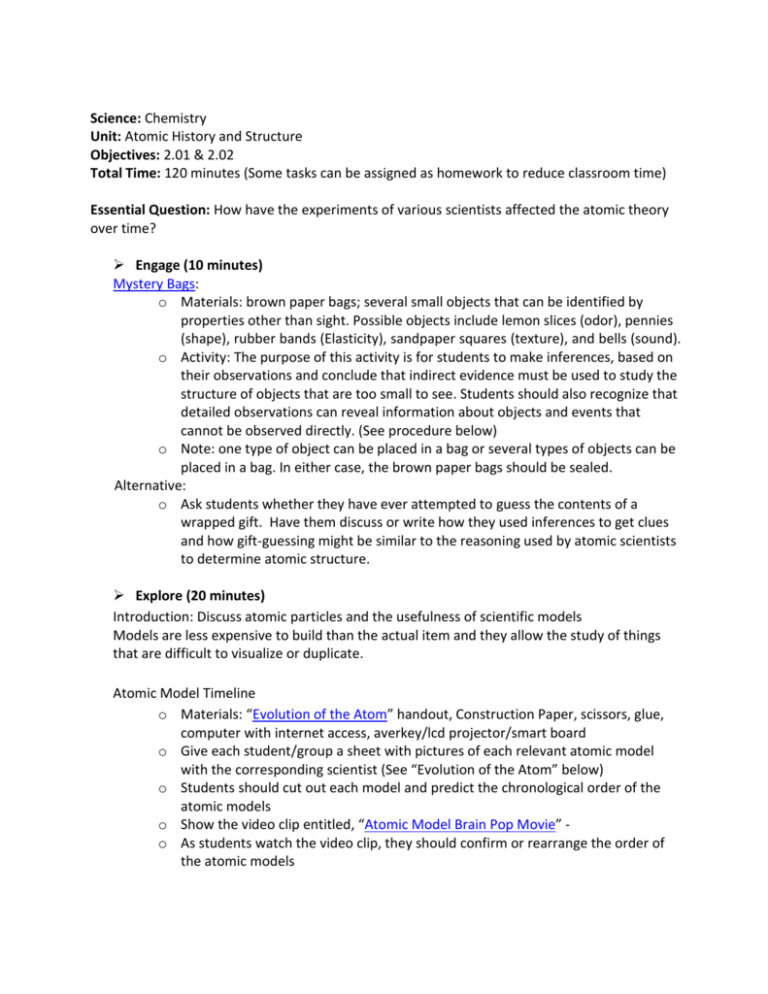
Science: Chemistry Unit: Atomic History and Structure Objectives: 2.01 & 2.02 Total Time: 120 minutes (Some tasks can be assigned as homework to reduce classroom time) Essential Question: How have the experiments of various scientists affected the atomic theory over time? Engage (10 minutes) Mystery Bags: o Materials: brown paper bags; several small objects that can be identified by properties other than sight. Possible objects include lemon slices (odor), pennies (shape), rubber bands (Elasticity), sandpaper squares (texture), and bells (sound). o Activity: The purpose of this activity is for students to make inferences, based on their observations and conclude that indirect evidence must be used to study the structure of objects that are too small to see. Students should also recognize that detailed observations can reveal information about objects and events that cannot be observed directly. (See procedure below) o Note: one type of object can be placed in a bag or several types of objects can be placed in a bag. In either case, the brown paper bags should be sealed. Alternative: o Ask students whether they have ever attempted to guess the contents of a wrapped gift. Have them discuss or write how they used inferences to get clues and how gift-guessing might be similar to the reasoning used by atomic scientists to determine atomic structure. Explore (20 minutes) Introduction: Discuss atomic particles and the usefulness of scientific models Models are less expensive to build than the actual item and they allow the study of things that are difficult to visualize or duplicate. Atomic Model Timeline o Materials: “Evolution of the Atom” handout, Construction Paper, scissors, glue, computer with internet access, averkey/lcd projector/smart board o Give each student/group a sheet with pictures of each relevant atomic model with the corresponding scientist (See “Evolution of the Atom” below) o Students should cut out each model and predict the chronological order of the atomic models o Show the video clip entitled, “Atomic Model Brain Pop Movie” o As students watch the video clip, they should confirm or rearrange the order of the atomic models o At the end of the video clip, students should then paste the pictures of the models on a piece of construction paper in chronological order(timeline) and write down a characteristic that distinguishes each model from the previous model o Please note: The timeline can be done on an individual basis or in collaborative small groups Elaborate ( 10 minutes) Atomic Candy o Materials – Assorted Candy (Suggestions – Blow pops, Kit-Kats, Snickers, gumballs) o Students (or Each collaborative group) should select 5 different pieces of candy o After each student has selected his or her candy, instruct the students match each piece of candy to the atomic model. o Students should record which candy was selected for each atomic model and write an explanation/analogy of how the piece of candy is similar to the particular atomic model o Alternative materials: Sports equipment (basketball, tennis racket, etc.), small office products (paperclips, safety pins, etc.), pictures of food, model or pictures of various cars, etc. Explain (20 minutes) History of the atom graphic organizer o Teacher will guide students through the History of the Atom PowerPoint Presentation and the “History of the atom” graphic organizer experiments o Students will fill in blanks and sketch the various experiments and models o Online Animation: This animation discusses Thomson’s model and the Rutherford Gold Foil Experiment. It also explains and gives a visual of how Rutherford’s expected results differed from his actual results. Elaborate (30 min) o Option 1: Students will work in collaborative groups (group roles can include – recorder, reporter, timekeeper, and facilitator) through the sheets explaining each relevant experiment. Each collaborative group should be responsible for reviewing a portion of the experiment with the entire class The Dalton Model Understanding the Rutherford Model o Option 2: Lab - Discovering charged particles within the atom o Extension: Students can create a model to “recreate” one of the scientist’s experiments Evaluate (30 min ) o Student Generated Quizzes Students should work in collaborative groups and use Marzano Levels of Thinking question stems to generate 10 questions (with answers) related to the development of the atomic theory. (See template below) Students groups can then challenge other student groups by asking quiz questions to other groups. o Project: Students will create a product that includes all of the key scientists involved in the evolution of the atomic theory, the corresponding model, and their contributions. Projects can be done outside of class individually or in groups. Time for presentations can be incorporated into class time after the project due date. Suggested product options are as follows: Children’s book: Students will make a CREATIVE Children’s book or comic strip explaining what an atom is and how it has evolved over time. The book or comic strip should be written so that an elementary school student can understand its content. Atomic Biography: Have students write a narrative describing the changes in the atomic model through time from the perspective of the atom Talk Show: Each group can become an expert on one of the atomic theory scientists and serve on a “atomic model” panel Historical Role Play: Students can act out an experiment or conversation by an atomic scientist or debate between the various scientists defending their atomic models Debate/Persuasive Essay – Student will select one of the scientists who contributed to the atomic theory and defend why this scientist’s contribution was the most significant Links on Persuasive Writing o http://www.writeexpress.com/persuasive-essay.html o http://www.orangeusd.k12.ca.us/yorba/persuasive_writ ing.htm Other suggestions include: mneumonic devices, story, interview with the atom, newspaper story, 3-d models, atomic mobile, newscast, poem, rap, song, essay, time line, website, PowerPoint Mystery Bags Procedure: 1. Make and record observations about the contents of the sealed brown paper bags provided by your teacher. Use your senses of touch, smell, and hearing to help you make your observations. 2. Based on your observations, predict what objects could be in each bag. Decide whether there is a single object or more than one object in each bag. Data Table: Bag Number Observations Analysis: 1. What evidence did you use to predict what objects were in the bags and how many objects were in the bags? 2. Propose an experiment that could test one of your predictions. 3. Infer how the skills used in this activity could be applied to the study of atoms. Bloom’s & Marzano’s LEVELS OF THINKING Elevate your thinking! Levels Evaluating Integrating / Synthesis Generating Analyzing Applying Organizing / Comprehension Knowing Associated Verbs Judge Evaluate Rate Verify Assess Define Criteria Combine Summarize Design Imagine Generalize Conclude Predict Infer Explain Elaborate Outline Diagram Differentiate Analyze Apply Make Show Record Construct Demonstrate Illustrate Categorize Group Classify Compare / Contrast Interpret List Name Label Recall Identify Match Choose Question Stems How would you prove…? disprove…? What would you cite to defend the actions…? How would you prioritize…? What information would you use to support the view…? Which … is most significant and why? Judge what would be the best way to…? Design a plan for …. How would you summarize…? What generalizations can you make about…? How would you adapt to …to create a different…? Can you predict the outcome if …? How many ways can you think of …? What would happen if…? Elaborate about…. What solutions would you suggest for …? What are the attributes of…? What patterns or relationships do you see? What are the main ideas of…? Can you diagram, web or map this idea? What are the different parts of…? How is …related to…? How is … an example of …? How would you use this information to…? What do you need to solve this problem? How would you organize … to show…? How would you apply what you learned to develop…? Categorize …according to…. Classify … according to…. How is … alike or different from …? What is most or least important about…? How would you rephrase the meaning of …? What is…? How did … happen or occur? Who did…? Identify the … and …. Which … best describes…? Which … is an example of …? What best defines…? Student Generated Quiz: (Sample) Atomic Structure & History Create a 10 question quiz related to Atomic Structure & History. You must use a question stem from each level of thinking on the Marzano chart provided for you. You must also attach an answer key to your quiz. You may just see your questions on our next quiz or test! No. 1 Level of Thinking Knowing Question -What theory did Dalton propose about the structure of matter? -What did Rutherford discover about the structure of an atom? -What did Bohr contribute to the modern atomic theory? 2 Comprehension/or ganizing 3 Applying -How is Dalton’s atomic theory alike and different from the modern atomic theory? -How did Ernest Rutherford discover the nucleus? -What evidence did Thomson have that his glowing beam contained negative particles? -What evidence did Thomson provide about the structure of an atom? In the Rutherford experiment, why weren’t all the alpha particles deflected? -Why must indirect evidence be used to study the structure of atoms? -What evidence convinced Dalton that elements must be made of individual particles called atoms? -What is the main difference between Bohr’s model of the atom and that atomic theory that is currently accepted? Why was Dalton’s model of the atom changed after Thomson’s experiment? 4 Analyzing -Explain why scientists accepted Dalton’s atomic theory but not the idea of an atom proposed by the Greek philosophers? 5 Generating -If you observed a beam of particles being bent toward a negatively charged plate, what might you conclude? - How would the results of Thomson’s experiment change if the beam were a stream of neutrons instead of a stream of electrons? -Create a survey you could use to determine what people know about the modern model of the atom. Figure out the best order for the questions to test someone’s knowledge fairly. Be prepared to explain your choices. 6 Integrating/ Synthesis 7 Evaluating 8 You Choose: Comprehension or Applying 9 You Choose: Analyzing or Generating 10 You Choose: Integrating or Evaluating -Judge which atomic model is the most significant to our current understanding of the atom? Please support your answer. -Was Rutherford’s model of an atom incorrect or incomplete? Explain your answer. Student Generated Quiz: Atomic Structure & History Create a 10 question quiz related to Atomic Structure & History. You must use a question stem from each level of thinking on the Marzano chart provided for you. You must also attach an answer key to your quiz. You may just see your questions on our next quiz or test! No. 1 Level of Thinking Knowing 2 Comprehension/or ganizing 3 Applying 4 Analyzing 5 Generating 6 Integrating/ Synthesis 7 Evaluating 8 You Choose: Comprehension or Applying 9 You Choose: Analyzing or Generating 10 You Choose: Integrating or Evaluating Question History of the Atom Democritus 400 BC Aristotle 400 BC John Dalton 1800’s J. J. Thompson 1897 Major Contribution Major Contribution Major Contribution Transformed _____________ ideas on atoms into a _______________________ Major Contribution Discovered the ___________ Proposed the ____ ______________ Other Information: Stated that _____ substances are made of 4 _________. 1. 2. 3. 4. Other Information: Conducted the ___________ ______________ experiment Dalton’s Atomic Theory 1) All _________ is made of tiny ______________ particles called __________ 2) The atoms of the same element are ______________, those of different elements are ______________ Major Contribution Determined the ____________and ______________ of the electron Cathode Ray Tube Experiment By adding an _________________ he found that the moving pieces were _____________________ 3) Atoms of different ____________ combine in small, _____________ ratios to form _________________ 4) Chemical reactions involve the ___________________ of atoms. No new atoms are ________________________ (Law of _________________ _______________________) Robert Millikan 1909 Use the diagram above to sketch the results of Thomson’s experiment Plum pudding model Displays electrons ______________ in a sphere of __________ charged material Use the diagram above to sketch the model Conducted ______ _______________ by measuring the effect of an electric field on very small oil droplets. From the _______ of the drop and the ________on the plates, he calculated the ____________on an _____________ History of the Atom Continued Ernest Rutherford 1912 Neils Bohr 1913 Major Contribution Discovered the ___________________ Gold Foil Experiment Expected Results Gold Fold Experiment Actual Results Rutherford’s Model Atoms of gold foil Au foil Au Foil Screen Use the diagram above to sketch the EXPECTED behavior of the alpha particles Screen Use the diagram above to sketch the ACTUAL behavior of the alpha particles Major Contribution Proposed that an ______is found only in specific circular paths, or _______, around the _____________ Bohr’s Model Referred to as __________ _______because electrons move around the ____________ like planets around the ________ Use the diagram of the above to sketch the behavior of the alpha particles according to Rutherford’s proposed model Major Contribution Confirmed the existence of __________in the _______________ Modern View Current -The _________ is mostly _________ space -The atom consists of _______ regions -Nucleus in center and contains ______ and __________ See Prentice Hall Text p. 107 or Modern Chemistry pp.72-73 Rutherford made 2 major conclusions from his Gold Foil Experiment: Sir James Chadwick 1932 The ______________ is made up of mostly ______________________ The atom contains a ____________________________ piece at center What experimental evidence led to Rutherford’s conclusion? Use the diagram above to draw a Bohr model of a Lithium Atom -The __________ _______ is the region where electrons in areas of high ______________ called atomic ______________ History of the Atom Democritus 400 BC Aristotle 400 BC Major Contribution Major Contribution Stated that all substances are made of 4 elements. Proposed the idea of the atom -Greek philosopher - smallest unit of matter atomos -competing ideas with Aristotle John Dalton 1800’s Major Contribution Transformed Democritus’ ideas on atoms into a scientific theory J.J. Thomson 1897 Major Contribution Discovered the electron Conducted the Cathode Ray Tube experiment Dalton’s Atomic Theory 1. 2. 3. 4. earth fire water air -Greek Philosopher -Ideas were carried throughout the middle ages 1) All matter is made of tiny indivisible particles called atoms 2) The atoms of the same element are identical, those of different elements are different 3) Atoms of different elements combine in small, whole-number ratios to form compounds 4) Chemical reactions involve the rearrangement of atoms. No new atoms are created or destroyed (Law of conservation of mass) Robert Millikan 1909 Cathode Ray Tube Experiment By adding an electric field he found that the moving pieces were negative Use the diagram above to sketch the results of Thomson’s experiment Plum pudding model Displays electrons embedded in a sphere of positively charged material Use the diagram above to sketch the model Major Contribution Determined the mass and charge of the electron Conducted oil drop experiment by measuring the effect of an electric field on very small oil droplets. From the mass of the drop and the charge on the plates, he calculated the charge on an electron History of the Atom Continued Lord Rutherford 1912 Neils Bohr 1913 Major Contribution Discovered the nucleus Gold Foil Experiment Expected Results Gold Fold Experiment Actual Results Rutherford’s Model Bohr’s Model Atoms of gold foil Au foil Au Foil Screen Screen Use the diagram above to sketch the expected behavior of the alpha particles Use the diagram above to sketch the actual behavior of the alpha particles Major Contribution Proposed that an electron is found only in specific circular paths, or orbits, around the nucleus Referred to as Planetary Model because electrons move around the nucleus like planets around the sun Use the diagram of the above to sketch the behavior of the alpha particles according to Rutherford’s proposed model Most alpha particles passed through the gold atoms (Only a few were greatly deflected) leading to the conclusion that atom is mostly empty space Therefore, the mass and positive charge are concentrated in a small region of the atom, which he coined the nucleus. The particles that approach the nucleus are deflected Major Contribution Confirmed the existence of neutrons in the nucleus Modern View Current -The atom is mostly empty space -The atom consists of two regions See Prentice Hall Text p. 107 or Modern Chemistry pp.7273 Rutherford made 2 major conclusions from his Gold Foil Experiment: The atom is made up of mostly empty space The atom contains a small, dense, and positive piece at center What experimental evidence led to Rutherford’s conclusion? Sir James Chadwick 1932 Use the diagram above to draw a Bohr model of a Lithium Atom -Nucleus in center and contains protons and neutrons -The electron cloud is the region where electrons in areas of high probability called atomic orbitals

